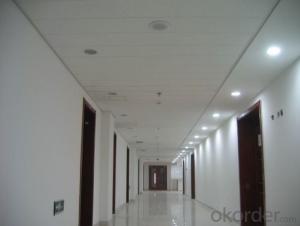When it comes to designing a space, one of the often overlooked elements is the ceiling grid. Its not just about aesthetics; it plays a crucial role in the overall functionality and feel of the room. But with so many sizes and styles available, choosing the right ceiling grid size for your space can be a daunting task. Lets dive into the world of ceiling grids and explore how to find the perfect fit for your space.
The Importance of Ceiling Grids
Ceiling grids are more than just a design element; they serve a practical purpose as well. They provide a framework for the installation of lighting fixtures, air vents, and other essential components. They also help in hiding any unsightly wiring or ductwork, giving your ceiling a clean and polished look.
Understanding the Basics
Before we get into the specifics of choosing the right size, its important to understand the basic components of a ceiling grid system. Typically, a grid system consists of main tees, cross tees, and angle tees. The main tees run parallel to the longer walls, while the cross tees run perpendicular to them. Angle tees are used at the corners to complete the grid.
Factors to Consider
When choosing the right ceiling grid size, there are several factors to consider:
– Room Size: The size of your room plays a significant role in determining the grid size. Larger rooms may require a more substantial grid to support the necessary infrastructure.
– Ceiling Height: The height of your ceiling will also influence the grid size. Higher ceilings may require a larger grid to maintain proportion and balance.
– Purpose of the Space: The intended use of the space will dictate the types of fixtures and vents youll need, which in turn will affect the grid size.
– Aesthetic Preferences: Your personal style and design preferences will also play a role in the grid size you choose. Some people prefer a more open and airy feel, while others may opt for a more structured and closed look.
Common Grid Sizes and Their Uses
Now that weve covered the basics, lets take a look at some common grid sizes and their typical uses:
– 2×2 Grid: This is a smaller grid size, often used in residential spaces or smaller commercial areas. Its perfect for rooms with lower ceilings and fewer fixtures.
– 2×4 Grid: A more common choice for larger commercial spaces, this grid size offers more flexibility in terms of fixture placement and can accommodate a wider range of infrastructure needs.
– Custom Grids: For those who want a truly unique look or have specific requirements, custom grids can be designed to meet any spaces needs.
Personalizing Your Space with Ceiling Grids
One of the best parts about ceiling grids is the ability to personalize your space. Whether youre going for a sleek, modern look or a cozy, rustic feel, the right grid size can help you achieve your desired aesthetic.
– Industrial Style: For an industrial look, consider using larger grids with exposed pipes and ductwork. This creates a raw, open feel thats perfect for open-plan spaces.
– Modern Minimalism: If minimalism is your goal, opt for a smaller grid size with clean lines and a simple color palette. This will create a sense of openness and simplicity.
– Warm and Cozy: For a warmer, cozier feel, consider using a grid with softer lines and a more intricate design. This can add texture and depth to your space.
The Impact of Ceiling Grids on Lighting and Airflow
Ceiling grids also have a significant impact on the lighting and airflow within a room. By strategically placing fixtures and vents within the grid, you can create a more balanced and comfortable environment.
– Lighting: The grid can help distribute light evenly throughout the space, reducing the need for additional fixtures and creating a more uniform lighting effect.
– Airflow: Properly placed vents can help circulate air more effectively, improving the overall comfort and air quality within the room.
Making the Right Choice
Choosing the right ceiling grid size is all about finding the perfect balance between functionality and aesthetics. Its important to take the time to consider your spaces needs and your personal preferences before making a decision.
– Consult with Professionals: If youre unsure about the best grid size for your space, dont hesitate to consult with professionals. They can offer valuable insights and recommendations based on their experience and expertise.
– Experiment with Layouts: Before committing to a specific grid size, experiment with different layouts and configurations to see what works best for your space.
– Consider Future Needs: Think about the potential changes in your spaces needs over time. A grid that works well now may not be suitable in the future, so its important to choose a flexible and adaptable system.
Wrapping Up
In conclusion, the right ceiling grid size can make all the difference in the functionality and appearance of your space. By considering factors such as room size, ceiling height, purpose, and personal style, you can find the perfect fit for your space. Remember to consult with professionals, experiment with layouts, and consider future needs to ensure you make the right choice. With the right ceiling grid, you can create a space that is both practical and visually appealing.

